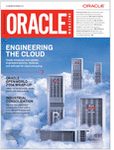Oracle Unified Method (OUM) Implement Core Workflow Part-1
Posted by Kashif Manzoor on 19th October 2011
I will be describing the OUM Implement Core Workflow and its purpose, We should also be able to recognize that there are many different views to access the OUM Implement focus area method material.
OUM Focus Areas
These three focus areas provide frameworks for project and program management, enterprise level planning and project implementation.
The Manage focus area provides a framework in which all types of projects can be planned, estimated, controlled, and completed in a consistent manner.
The Manage focus area contains the material from the Project Management and Program Management methods – PJM and PGM.The fundamental responsibility of the project manager is to manage a project and agreed on level of quality while planning for and controlling the “triple constraints” of scope, cost and schedule.
OUM’s Manage Focus Area is designed to support the project manager in fulfilling these responsibilities. The Manage Focus Area works closely with the Envision and Implement focus areas by wrapping around the project.
The Envision focus area comprises the areas of the Oracle Unified Method framework that deal with development and maintenance of enterprise-level IT strategy, architecture, and governance.
The purpose of the Envision focus area are: (1)To provide a set of processes that can be adopted by an enterprise in order to better align IT delivery with Business strategy, (2) To provide a framework for development of services that support enterprise or strategic level interactions, (3) To provide the context for OUM based delivery services and connect those services to the larger IT lifecycle.
Envision extends OUM’s capabilities beyond delivery and management of software implementation projects into the realm of IT vision and strategy. Envision is focused on information technology related business architecture and practices.
The Implement focus area provides a framework to develop and implement Oracle-based business solutions with precise development and rapid deployment.
The OUM Implement Focus Area is to be applied to IT projects and documents the project execution processes.
The OUM implementation architecture provides a rapid, adaptive, and business-focused, approach to Implementation.
This diagram illustrates a typical OUM project, with a typical number of iterations. The relative amount of effort performed in each process, during each iteration is represented by the height of the colored bars for each process. The number of iterations performed and the amount of effort required for a particular project will vary depending upon a number of a factors, such as scope, technical and programmatic risk, system size, team size, etc. The number of iterations can vary from as few as 3 to as many as 12 or more. Projects may also employ multiple production releases, and therefore, multiple iterations of the entire lifecycle to fulfill all of the business requirements.
Full Method and Focus Areas
On OUM Home page, Select a View, in the Other views category, you can access the Full Method and Focus Areas page. This page describes and provides links to the full method views and the focus area views in OUM. These views would not be used to deliver a project but are provided as a reference tool.
There are two full method views; The Full Method view and the Full Method Activities and Tasks view. Both of these views provide access to all the method content for Manage, Envision and Implement. The Full Method view is organized by focus area and process. The Full Method Activities and Task view is organized in work breakdown structure order.
You can find previous note:
http://oraerp.com/blog/retirement-of-oracle-aim-release-of-oum/
More details can be found on:
http://www.oracle.com/partners/en/knowledge-zone/applications/oracle-unified-method-359405.html
Tags: Envision, Implement, Manage, OUM
Posted in OUM | No Comments »










 Oracle has announced retirement of Oracle Application Implementation Method (AIM) as of January 31, 2011. Oracle will no longer provide support for AIM Advantage or AIM for Business Flows. Oracle has released Oracle Unified Method (OUM) to achieve the vision of supporting the entire Enterprise IT lifecycle, including support for the successful implementation of every Oracle product.
Oracle has announced retirement of Oracle Application Implementation Method (AIM) as of January 31, 2011. Oracle will no longer provide support for AIM Advantage or AIM for Business Flows. Oracle has released Oracle Unified Method (OUM) to achieve the vision of supporting the entire Enterprise IT lifecycle, including support for the successful implementation of every Oracle product.